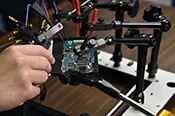
Our mission is to use specialized tools and techniques to recover data from electronic devices used or involved in criminal cases. From laptops and cell phones to gaming consoles and Internet of Things (IoT) devices, an increasing number and variety of gadgets are being used by both victims and perpetrators of crimes. The data stored on these items can include: web browser history, location data, messages and call records, and even user activity information as detailed as step counts and heart rate details! Collectively, this information can provide significant insight into the events and activity associated with a particular crime or incident. Digital Evidence analysts use advanced forensic tools and techniques to retrieve data, frequently encountering and overcoming such challenges as: encryption and passcodes, damaged and corroded devices, and deleted data recovery. Video enhancement is another available tool where we recover and clarify surveillance images and videos that are related to criminal cases. Critical evidence can come from a variety of sources, such as business or in-home video surveillance systems, cell phones, or hidden cameras. Once the data has been recovered, images and videos can be adjusted to reduce artifacts like those left behind by motion blur or inadequate lighting. The goal of this process is to provide the highest quality depiction of the event being investigated, while maintaining the integrity of the evidence. If needed by a court of law, an analyst may present their findings to a jury during a criminal trial.
 Florida Department of Law Enforcement
Mark Glass, Commissioner
Florida Department of Law Enforcement
Mark Glass, Commissioner